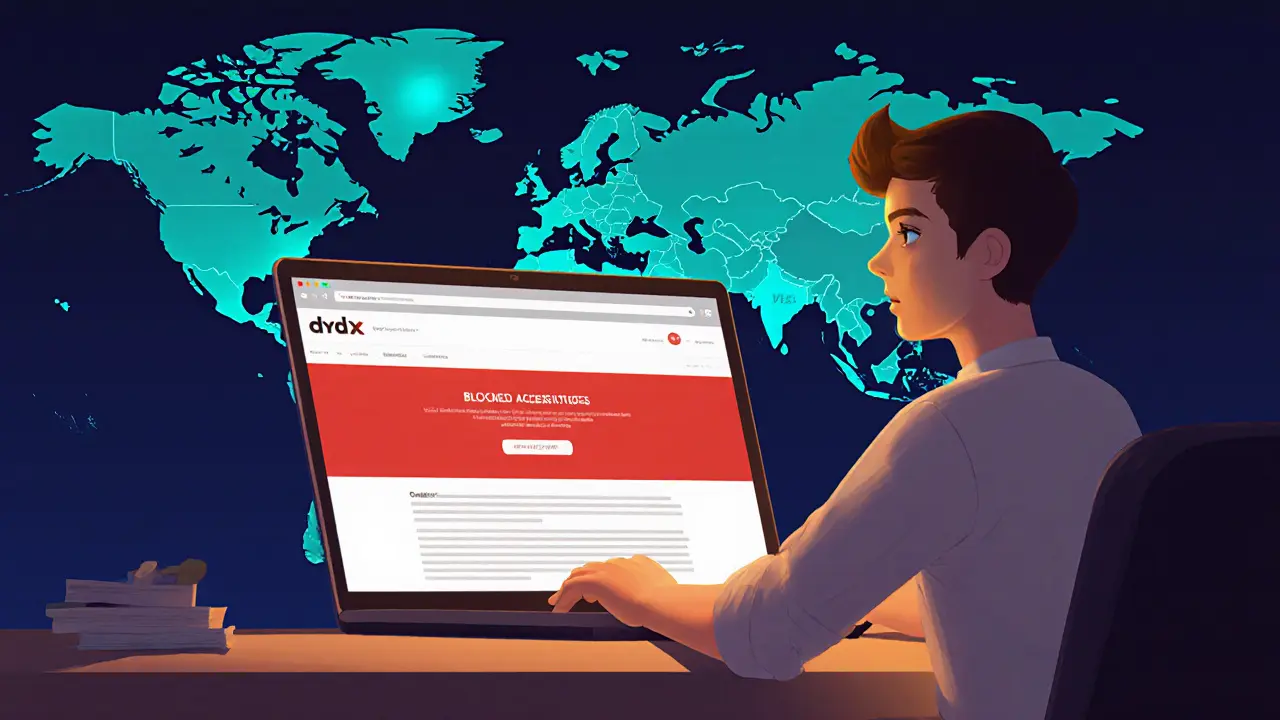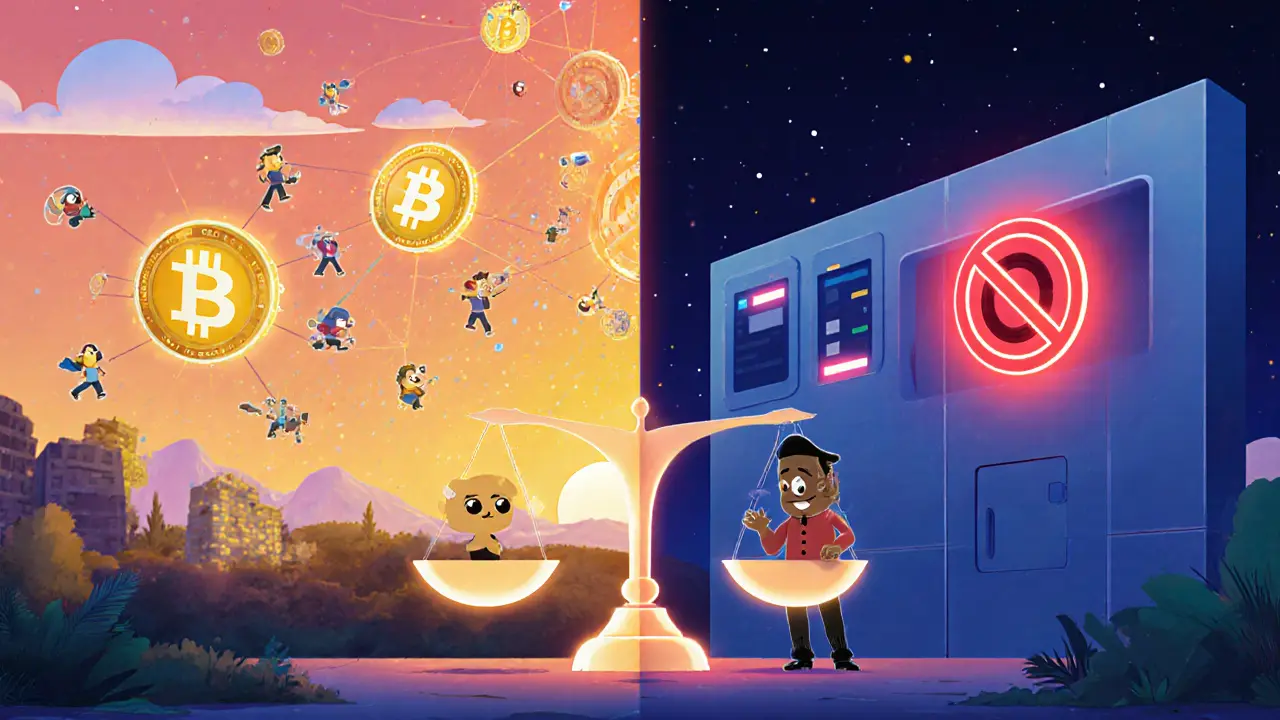 May, 21 2025
May, 21 2025
You've probably heard dYdX marketed as a truly decentralized crypto derivatives exchange. The tagline sounds great, but if you try to log in from a few parts of the world you hit an unexpected wall: the platform simply won’t let you trade. This article unpacks why dYdX restricts users in specific jurisdictions, how those blocks are technically enforced, and what the whole situation tells us about the gap between decentralization promises and real‑world compliance.
What is dYdX, Really?
dYdX is a crypto derivatives platform that lets traders open perpetual contracts on assets like Bitcoin, Ethereum, and Solana without giving up custody of their funds. Founded by Antonio Juliano in 2017, the exchange touts a “decentralized” architecture: order matching runs on smart contracts, and users interact through non‑custodial wallets.
In practice, the front‑end (the web UI at dydx.trade) is operated by a corporate entity called dYdX Operations Services Ltd. (DOS). That company decides which IP addresses can reach the UI, and it enforces a suite of compliance rules that look very much like the ones a centralized exchange would apply.
How dYdX Positions Itself as a Decentralized Exchange
The term Decentralized Exchange (or DEX) usually means there is no single authority that can freeze funds, block addresses, or modify protocol rules. dYdX’s smart‑contract core follows that model: trades are settled on‑chain, and anyone can read the order book.
However, the user experience is gated by a thin “web layer” that sits on top of that core. When you connect your wallet, DOS checks your IP against a geo‑blocking list. If you’re from a prohibited region, the UI immediately switches you into a restricted state, regardless of what the blockchain itself would allow.
Which Countries Are Blocked?
Below is a snapshot of the most commonly restricted jurisdictions as of October2025. The list is pulled from dYdX’s Terms of Service and public compliance statements.
| Restricted Country / Territory | Reason for Block |
|---|---|
| United States | U.S. sanctions & AML laws |
| United Kingdom | UK FCA requirements |
| Canada | Canadian securities regulations |
| Iran | U.S. OFAC sanctions |
| Cuba | U.S. sanctions |
| North Korea | UN sanctions |
| Syria | U.S. sanctions |
| Myanmar (Burma) | U.S./UN sanctions |
| Crimea, Donetsk, Luhansk | International sanctions |
| Iraq | Sanctions & AML checks |
| Libya | Sanctions regime |
| Mali | Sanctions & terrorism financing |
| DR Congo | AML/CTF controls |
| Côte d’Ivoire | Sanctions list |
| Nicaragua | U.S. sanctions |
| Somalia | Sanctions & CTF |
| Sudan | U.S. sanctions |
| Yemen | Sanctions |
| Zimbabwe | Sanctions & AML |
Technical Enforcement: Close‑Only Mode and Blocked Status
If you happen to be in one of those regions, dYdX doesn’t just show a “Sorry, not available” banner. The platform flags your wallet and forces it into “close‑only mode”. In this state you can:
- Cancel any open orders.
- Reduce or fully close existing positions using reduce‑only orders.
- Withdraw funds that are already on‑chain.
What you cannot do:
- Deposit new collateral.
- Open fresh positions or submit new limit orders.
- Transfer assets between sub‑accounts.
All new orders default to reduce‑only, and the UI displays a red warning banner that explains the compliance restriction. If the wallet stays in close‑only mode for seven straight days, the status upgrades to “Blocked”. At that point you lose access to the trading history, sub‑accounts, and any front‑end functionality. The only thing left is the ability to export your Secret Recovery Phrase, effectively forcing you off the platform while keeping your on‑chain assets safe.

Why Does dYdX Enforce These Blocks?
The root cause is simple: regulators worldwide still hold sway over any entity that wants to operate legally. dYdX’s corporate arms-dYdX Trading Inc. in New York and the dYdX Foundation in Zug-must comply with Anti‑Money‑Laundering (AML), Counter‑Terrorism Financing (CTF), and sanctions programs administered by bodies such as the U.S. Department of the Treasury’s Office of Foreign Assets Control (OFAC).
By blocking IPs and limiting wallet actions, dYdX can demonstrate to regulators that it is not facilitating illicit activity in prohibited jurisdictions. The approach also protects the platform from potential fines, asset freezes, or being cut off from banking services.
The Decentralization Paradox
True decentralization means no single party can dictate who can or cannot use the protocol. On the blockchain layer, anyone with a compatible wallet can interact with dYdX’s smart contracts. But because the front‑end UI is owned and operated by a legal entity, that entity can apply geographic filters and compliance rules.
In other words, dYdX offers a hybrid model: decentralized execution paired with centralized access control. This design enables the platform to stay on‑shore, maintain banking relationships, and avoid being classified as an illegal securities market, but it also means the “decentralized” claim has limits.
What Users Should Do to Stay Compliant
- Check Eligibility Before Signing Up - Visit dYdX’s Terms of Service and look for the latest list of restricted jurisdictions. The list can change as new sanctions are issued.
- Use a VPN cautiously - While a VPN can mask your IP, dYdX also checks wallet‑origin data and may flag suspicious activity. Relying on a VPN could lead to a close‑only transition.
- Monitor Wallet Status - The UI will display a banner if you’re in close‑only mode. Keep an eye on the countdown timer; once you hit seven days, the wallet becomes fully blocked.
- Plan Exit Strategies - If you anticipate being blocked (e.g., you’re traveling to a restricted country), withdraw your collateral beforehand. Remember that on‑chain assets remain yours; you can always move them to another wallet or DEX.
- Stay Informed - dYdX publishes updates when it adds or removes regions. Subscribe to their blog or community channels for real‑time notices.

Selective Accessibility: Why Some “Banned” Countries Remain Open
Interestingly, dYdX still allows users from China, Russia, South Korea, Japan, and Vietnam. This isn’t a random choice; it reflects a risk‑based compliance strategy. Those jurisdictions, while having regulatory scrutiny, haven’t been subjected to the same sanctions or AML mandates that trigger an outright ban. The platform therefore decides it can safely onboard users there while still meeting its legal obligations.
Bottom Line
dYdX’s country restrictions illustrate the growing tension between the ideal of a borderless, permissionless finance system and the practical need to obey global financial regulations. If you value true decentralization above all, you might look for pure‑protocol DEXs that have no front‑end gatekeeping. If you need advanced derivatives and are okay with some central control, dYdX still offers a powerful solution-provided you’re not in a blocked region.
Frequently Asked Questions
Can I use a VPN to bypass dYdX’s country restrictions?
A VPN may hide your IP, but dYdX also looks at wallet‑origin data and compliance flags. Using a VPN can trigger close‑only mode, and repeated attempts may lead to a full block. The safest route is to verify eligibility before connecting.
What happens to my funds if my wallet is placed in close‑only mode?
Your existing positions stay on‑chain. You can close or reduce them and you can withdraw any unlocked collateral. However, you cannot deposit new funds or open fresh trades until the restriction is lifted.
Are there any ways to regain full access after being blocked?
The only permanent fix is to satisfy the compliance requirements-usually by moving to a allowed jurisdiction. You can always withdraw your assets to another wallet or a truly permission‑less DEX.
Why does dYdX allow users from China but not from the United States?
The United States imposes strict securities and sanctions rules that require dYdX to block U.S. residents. China, while heavily regulated, does not fall under the same U.S. sanctions regime, so dYdX can legally offer its services there.
Is dYdX still considered a decentralized exchange despite these blocks?
On the protocol layer, yes-trades settle on‑chain without a custodian. On the user‑access layer, no-DOS controls who can reach the UI, making it a hybrid model rather than a pure DEX.
Laura Hoch
May 21, 2025 AT 09:09It’s a bitter pill to swallow when a platform that touts "decentralization" ends up policing you based on your passport. The irony is palpable, especially for folks who value financial sovereignty. dYdX’s smart‑contract layer might be open, but the UI acts like a gatekeeper with a checklist. You’re essentially forced to choose between compliance nightmares or abandoning the service altogether. That tension is exactly what the crypto community has been warning about for years.
Devi Jaga
May 24, 2025 AT 20:29Wow, another “groundbreaking” crypto solution that hides behind a compliance veneer. The jargon is impressive, the actual freedom? Diminishing.
Hailey M.
May 28, 2025 AT 07:49Ah, the drama of a “decentralized” exchange that suddenly turns into a digital border patrol! 😤 First you’re promised borderless finance, then a pop‑up tells you you’re out of bounds because of some obscure sanction list. The UI, which looks sleek, is actually a thin veneer that masks a corporate compliance engine. Every time you try to log in from a blocked nation, the platform slips into “close‑only” mode like a reluctant bouncer. You can still close positions, but you’re denied the very thing that made dYdX attractive: open trading. It feels like a betrayal of the core ethos that brought us to blockchain in the first place. The smart contracts still sit idly on‑chain, oblivious to the geo‑filter, but you can’t even reach them without a passport stamp. The irony is that the only thing truly decentralized is the risk you take when you try to outsmart the system. Some users resort to VPNs, only to trigger an even tighter clampdown and risk a full block. Others accept the reality and move their assets to a pure‑protocol DEX, abandoning the convenience dYdX offers. The whole situation underscores a paradox: you can have decentralized execution but centralized gatekeeping. Regulators love that loophole because it gives them a lever while the tech community cries foul. In the end, you’re left deciding whether you value regulatory safety or absolute freedom. 🎭 The choice, as always, reflects your risk appetite and philosophical stance on sovereignty. And remember, the blockchain never forgets, even if the UI does.
Kaitlyn Zimmerman
May 31, 2025 AT 19:09Dydx's hybrid model is a perfect example of how tech tries to walk a tightrope between innovation and regulation. The on‑chain side truly lives up to the decentralization hype but the front‑end acts like a traditional exchange. Users get the best of both worlds if they live in an allowed jurisdiction. If not, the gate keeps you out.
DeAnna Brown
June 4, 2025 AT 06:29Honestly this is exactly why I keep telling people to read the fine print and not get lured by shiny UI. The “decentralized” label is just marketing fluff when your IP gets blocked in seconds. You might think you’re on the cutting edge but you’re really just dancing to a corporate rhythm. It’s infuriating.
Chris Morano
June 7, 2025 AT 17:49I get the frustration, but remember the platform avoids hefty fines that could shut it down entirely. That risk would impact everyone, not just the blocked users. So the compromise, while annoying, preserves the overall ecosystem.
Ikenna Okonkwo
June 11, 2025 AT 05:09From a cultural perspective, it’s fascinating how different regions are treated unequally. The platform bans the US and Canada but still welcomes China and Russia, showing a selective risk calculus. This sends a message about geopolitical priorities rather than pure compliance. It’s a reminder that crypto isn’t immune to politics.
Bobby Lind
June 14, 2025 AT 16:29Wow!!! That’s a sharp observation!!! It really shows how the “borderless” narrative is more of a myth than reality!!!
Deborah de Beurs
June 18, 2025 AT 03:49So much for borderless finance.
Sara Stewart
June 21, 2025 AT 15:09Exactly, the promise of open access gets trampled by regulatory handcuffs. The irony is that the blockchain stays immutable while the UI bends to the law. Users need to diversify their entry points to stay truly free.
Schuyler Whetstone
June 25, 2025 AT 02:29Listen up, if you think the UI is just a harmless layer, think again; it’s the first line of defense that decides who gets to play. The aggressors behind the scenes can toggle permissions on a whim, and you’re left scrambling. That’s why I always say: don’t trust the front‑end blindly.
David Moss
June 28, 2025 AT 13:49There’s a deeper game at play; the powers that be use platforms like dYdX to funnel data back to intel agencies. By forcing users through a controlled gateway, they can monitor transactions without touching the chain. This covert surveillance is the real threat that most folks overlook. Keep your eyes open, people.
Pierce O'Donnell
July 2, 2025 AT 01:09Great insight, but honestly it’s just paranoia.
Vinoth Raja
July 5, 2025 AT 12:29While the sarcasm is noted, the underlying issue remains: the tokenomics don’t justify such heavy-handed restrictions, especially when the blockchain layer is unrestricted. Users deserve transparent governance, not opaque geo‑filters.